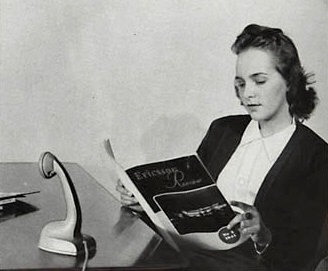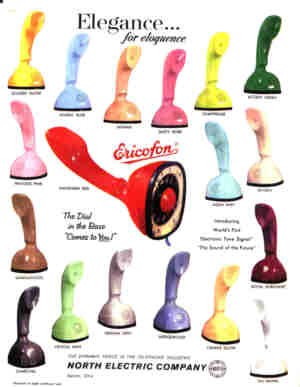Ericofon HistoryThis is a brief history of the
Ericofon, mostly involving the US market. The Ericofon, made by the L M Ericsson Company of Sweden, is perhaps one of the biggest steps forward in telephone design. World War II had produced a number of new materials. From Plastics to lightweight ferromagnetic materials, the door was opened for a new era in telephone development.
The Ericofon was produced for the European and Australian markets, with home use sales starting in 1956. Ericsson was unable to penetrate the American market with any success because of Bell Telephone's monopoly stranglehold on the telecommunications market. They absolutely refused to have these "foreign phones" go into use on their circuits. A lot of hype and propaganda concerning fears of damage to the system and such were used. After much wrangling, Ma Bell relented and allowed limited institutional use of the Ericofon, but still charging phone rent as though they had provided the phone (each phone in your home was rented from Bell during this era, you didn't own your own phone). Ma Bell felt so threatened by this one-piece phone design that they started research on their own version. This is what gave birth to the Trimline phone many years later.
Shortly before the transfer of manufacturing to America, around 1960, Ericsson had made a design modification to the Ericofon to accommodate a new molding method making a one piece shell instead of a two piece shell. This caused the phone to be a bit shorter and putting more of an angle to the receiver end. These are commonly referred to as "old case" or "new case" phones. This is why the American made Ericofons have the illusion of being shorter than the Swedish Ericofons. Sometime about 1967, Ericsson introduced the first version of the pushbutton Ericofon that used TouchTone dialing. These models (60A) are very hard to find because there was a poorly designed plastic part in the hook-switch mechanism that broke easily when the phone is dropped on a hard surface. In 1972, North Electric discontinued the Ericofon line and sold the remaining parts and equipment to a telephone refurbishing company named CEAC. They continued production for a short time before ceasing business. Meanwhile, back in Sweden, Carl-Arne Breger was busy designing a new Ericofon for Ericsson to celebrate the company's 100th Anniversary in 1976. Some skeptics suggest this was also an attempt to revive the Ericofon. The now squared off, modernized unit was dubbed the "Ericofon 700". It met with limited success and never did make it to the American market. CLICK HERE for a history of ericofon.com
|



